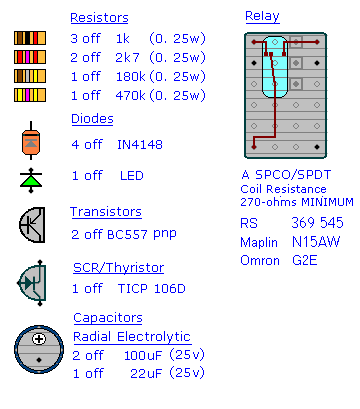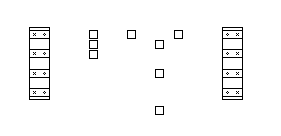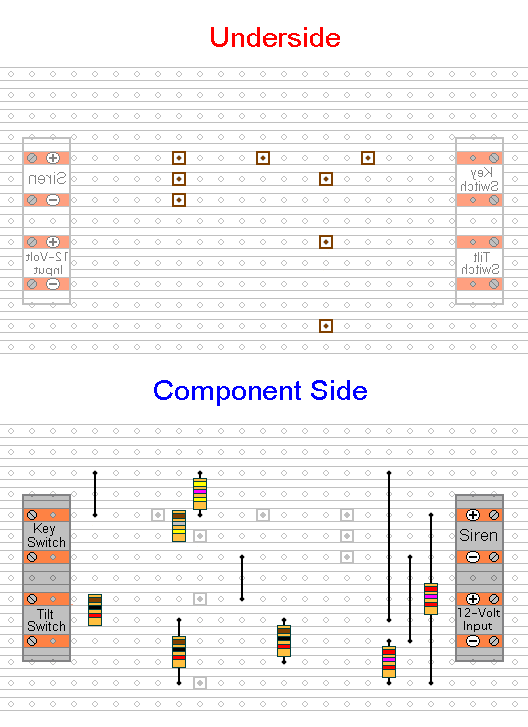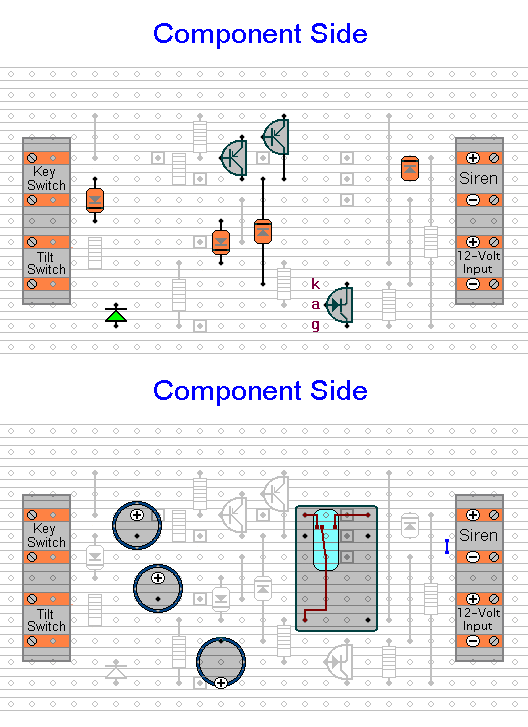The components used in the circuit should be widely available. However, none of them are critical. So - if you can't find the specified parts -
You're certain to find something that will do just as well.
The alarm is intended primarily for use on a motorcycle. I didn't want the circuit to drain the motorcycle battery - so I designed it to have zero standby current. This was achieved by using a normally-open trigger switch - and by making sure that when the alarm is set - there are no purely resistive connections between the positive rail and ground.
The low standby current means that the alarm may be powered by dry-batteries. This would make it more secure - because it could not be defeated by disconnecting the motorcycle battery. It also means that the alarm may be used in situations where a power source is not available. For example - it could be fitted inside anything that's in danger of being picked up and carried away.
Parts List
Click Here For A Photograph Of The Prototype.

Construction Notes
Click here if you're new to constructing stripboard projects.
The terminals are a good set of reference points. To fit them - you may need to enlarge the holes slightly. Then turn the board over and use a felt-tip pen to mark the 8 places where the tracks are to be cut. Before you cut the tracks - use the "actual size" drawing - to
Check Your Pattern is correctly marked.
Actual Size

When you're satisfied that the pattern is right - cut the tracks. Make sure that the copper is cut all the way through. Sometimes a small strand of copper remains at the side of the cut - and this will cause malfunction. Use a magnifying glass - and backlight the board. It only takes the smallest strand of copper to cause a problem. If you don't have the proper track-cutting tool - a 6 to 8mm drill-bit will do. Just use the drill-bit as a hand tool - there's no need for a drilling machine.

Next fit the seven resistors and the
Four Wire Links. For the links - I used bare copper wire on the component side of the board. Telephone cable is suitable - the single stranded variety used indoors to wire telephone sockets. Stretching the core slightly will straighten it - and allow the insulation to slip off.
Then fit the two transistors the four diodes and the SCR. Pay particular attention to the orientation of the diodes. Note that the cathodes of D1 & D2 (the end with the bar) are facing downwards. You'll want to fit the LED remotely. But for the present - tack it in place on the board - temporarily.

The next stage is to fit the three capacitors and the relay. Radial electrolytic capacitors generally have a stripe down one side of the can - next to the
negative lead. Note that the bottom capacitor - C3 - is mounted with its
positive terminal towards the bottom of the board.
Examine the underside of the board carefully - to make sure that there are no unwanted solder bridges or other connections between the tracks. If you backlight the board during the examination - it makes potential problem areas easier to spot.
When you're satisfied that everything is in order - add the single (blue) solder bridge to the underside of the board. It's just a small blob of solder - that connects the negative Siren terminal - to the track above.
You Are Now Ready To Test Your Alarm